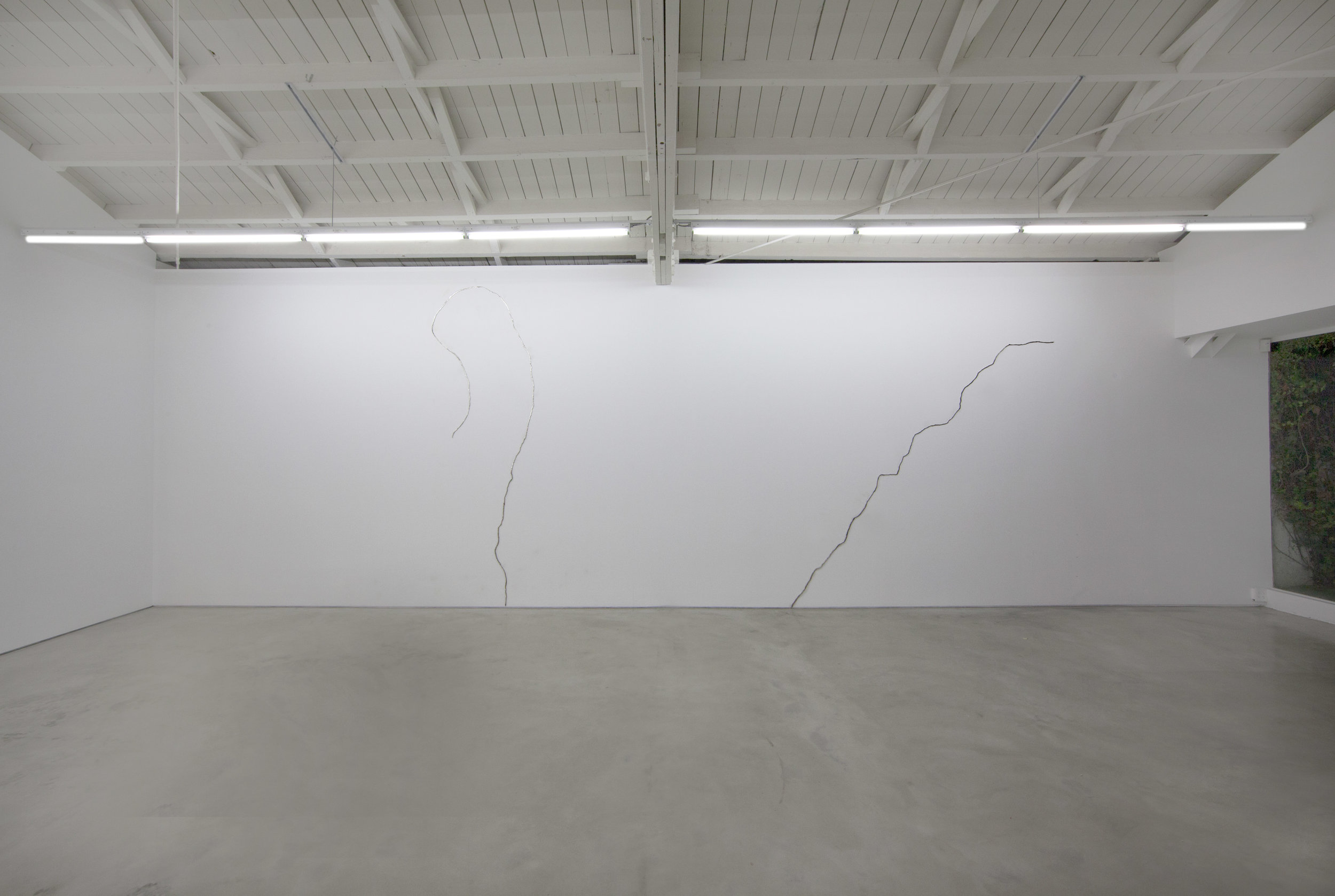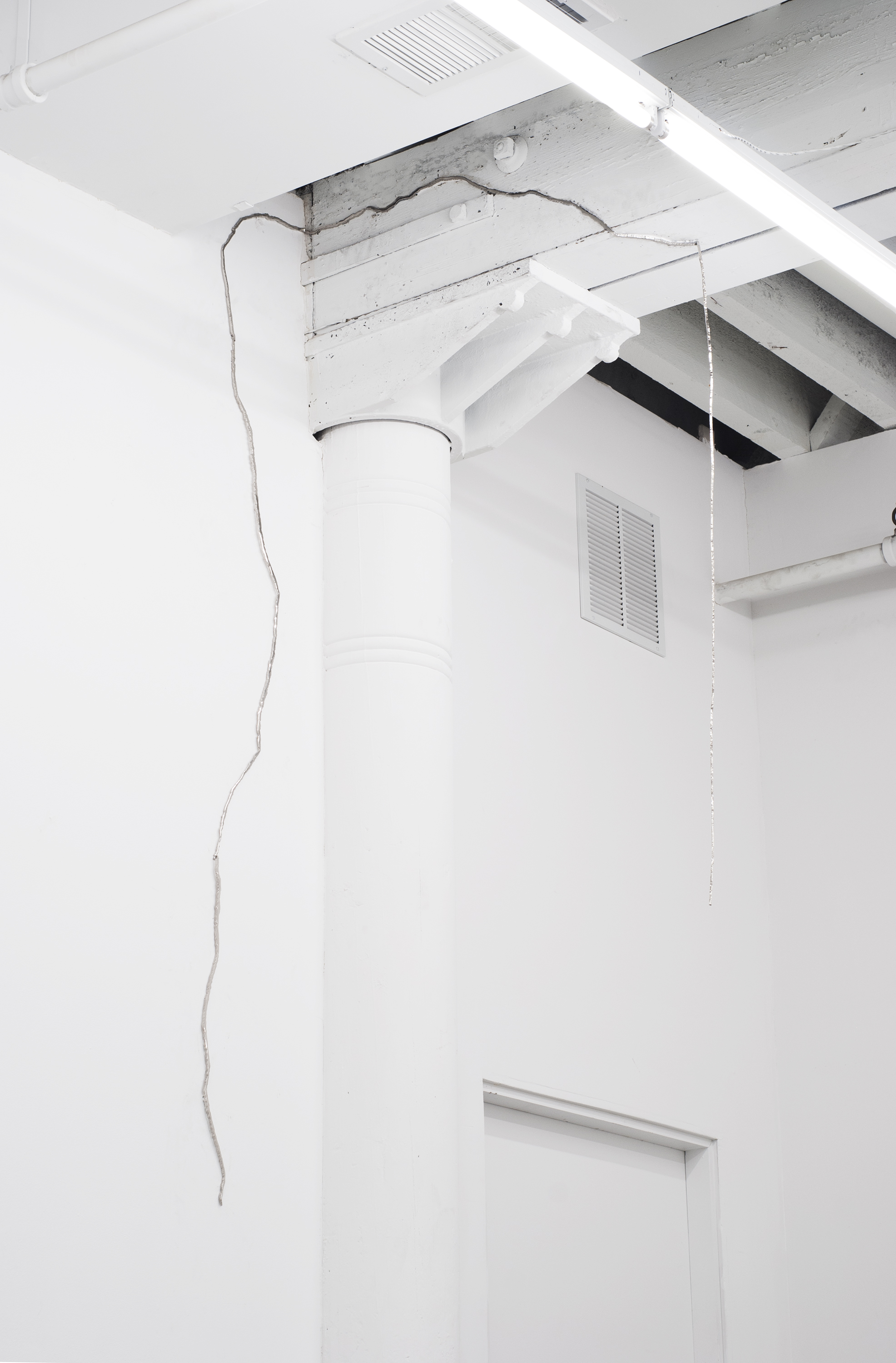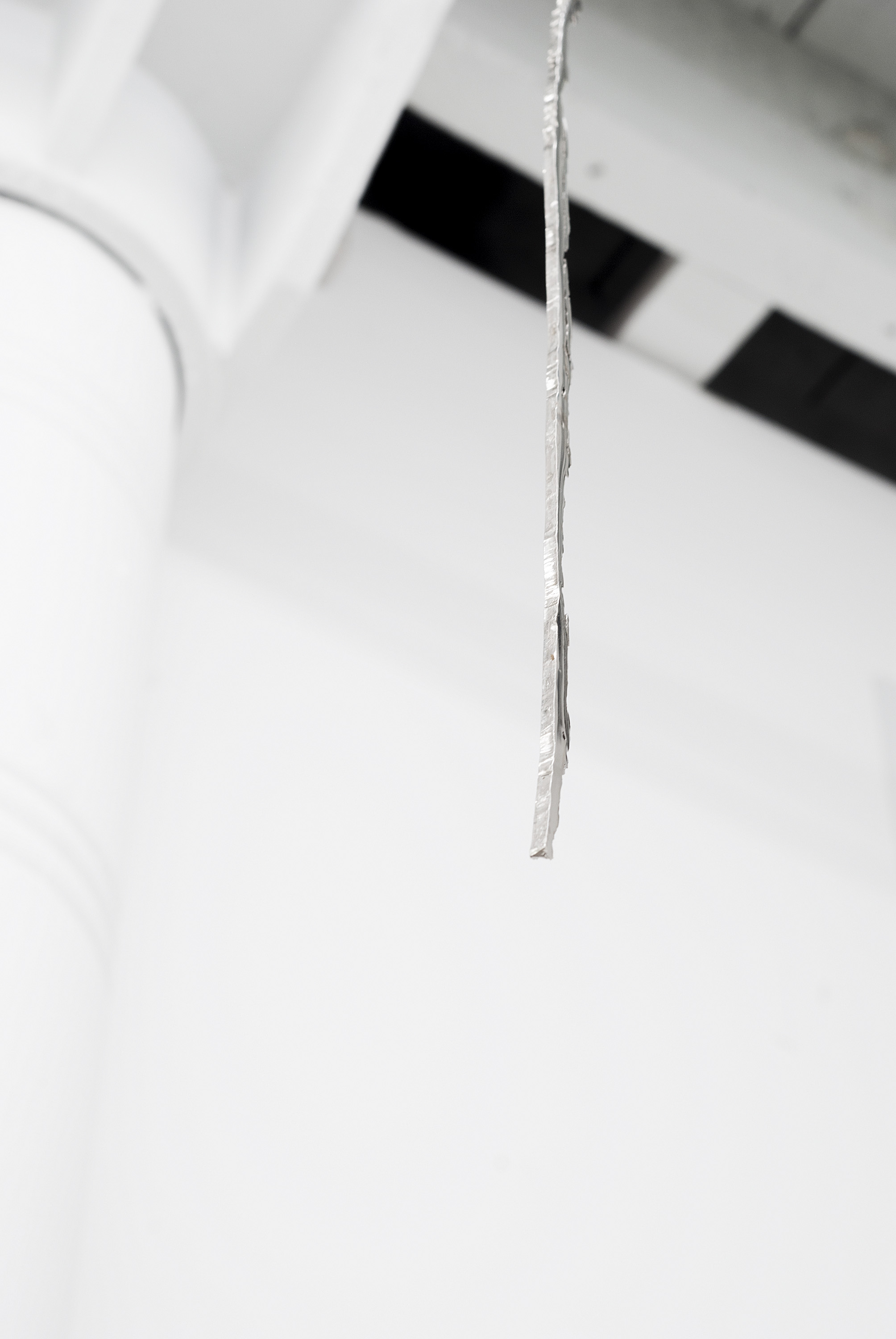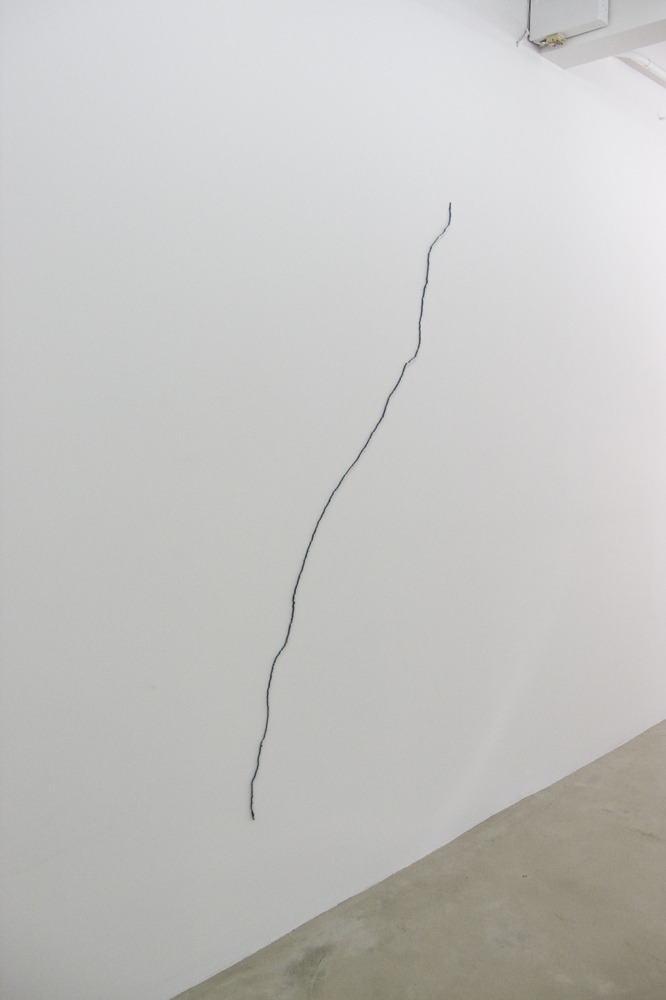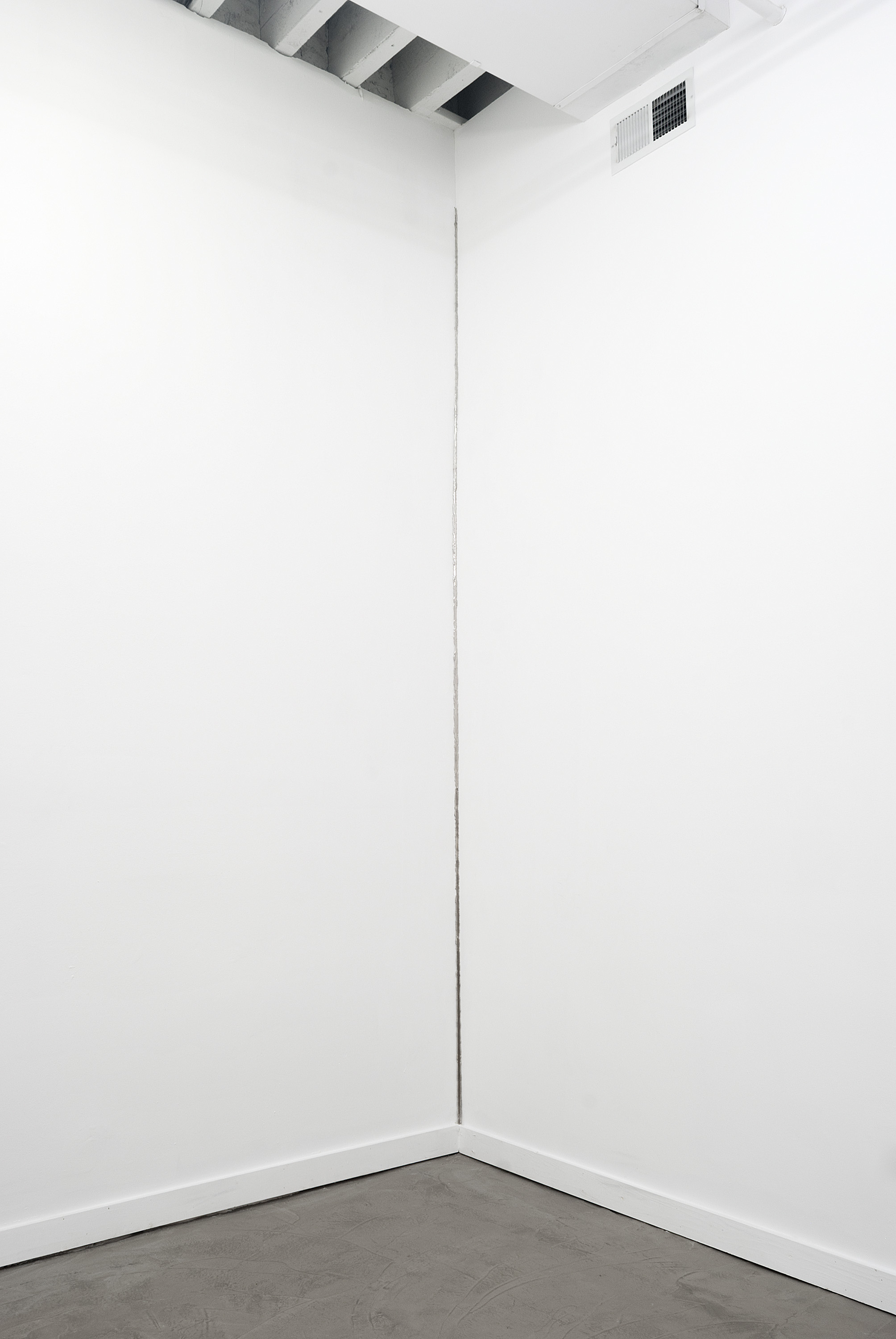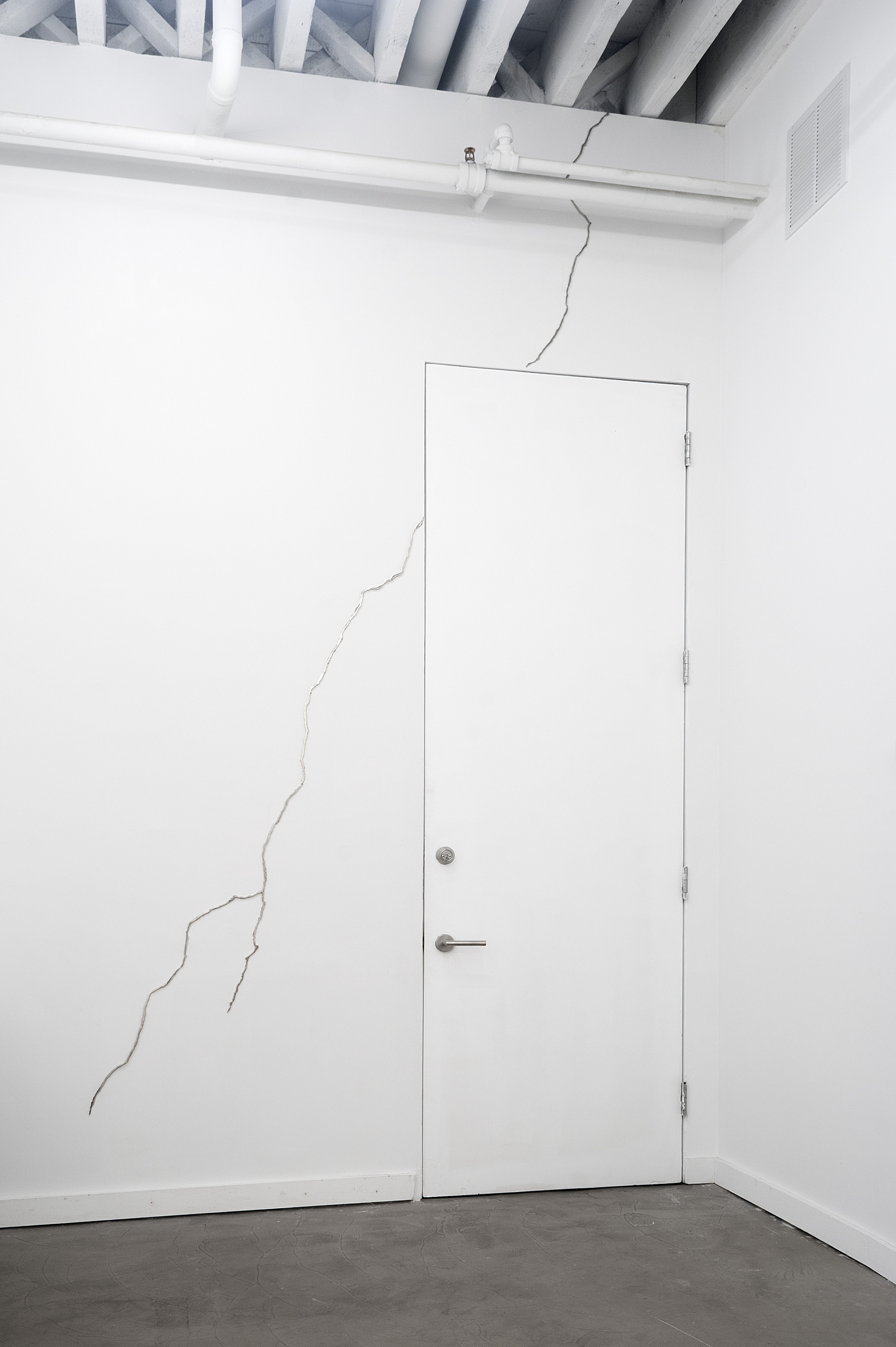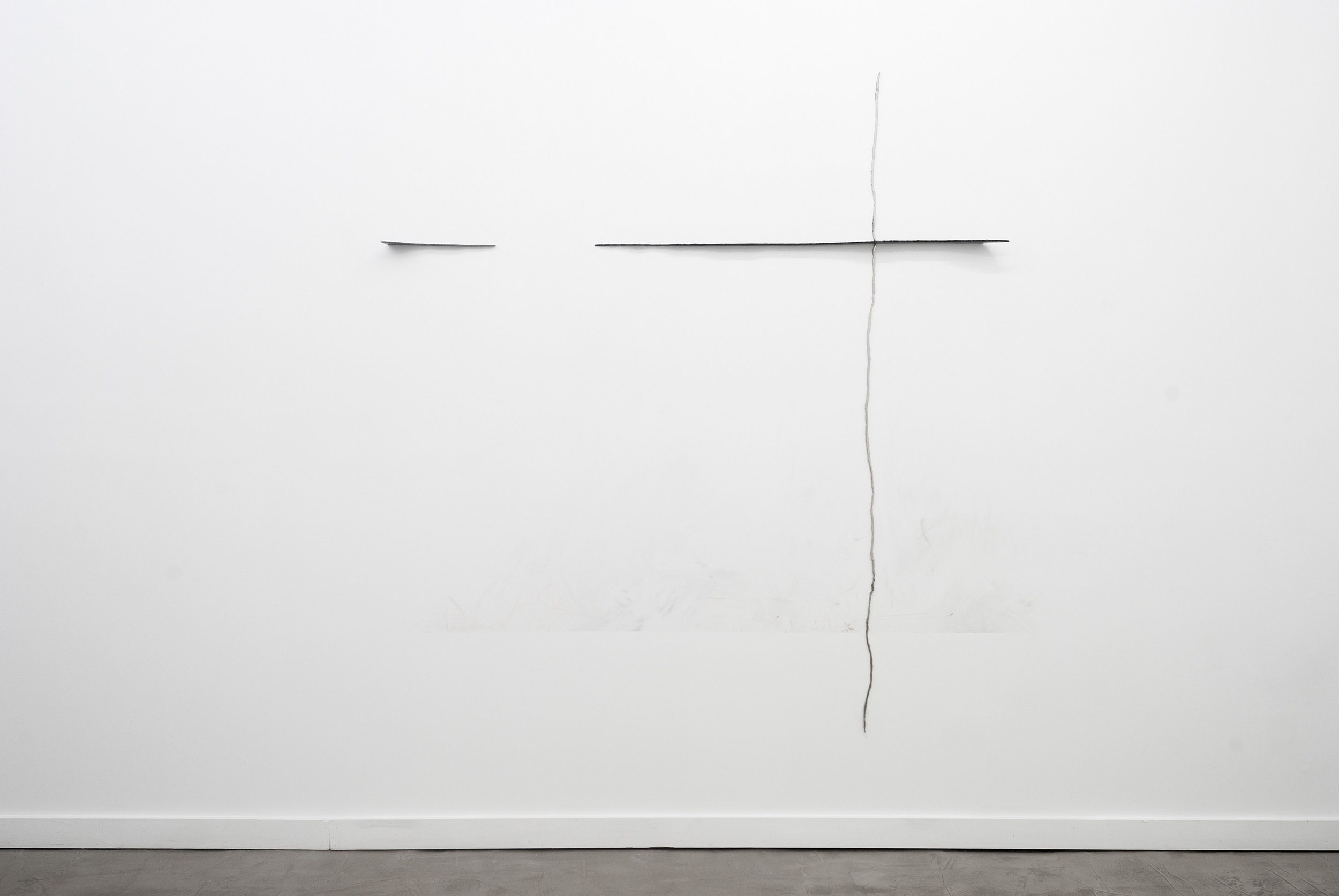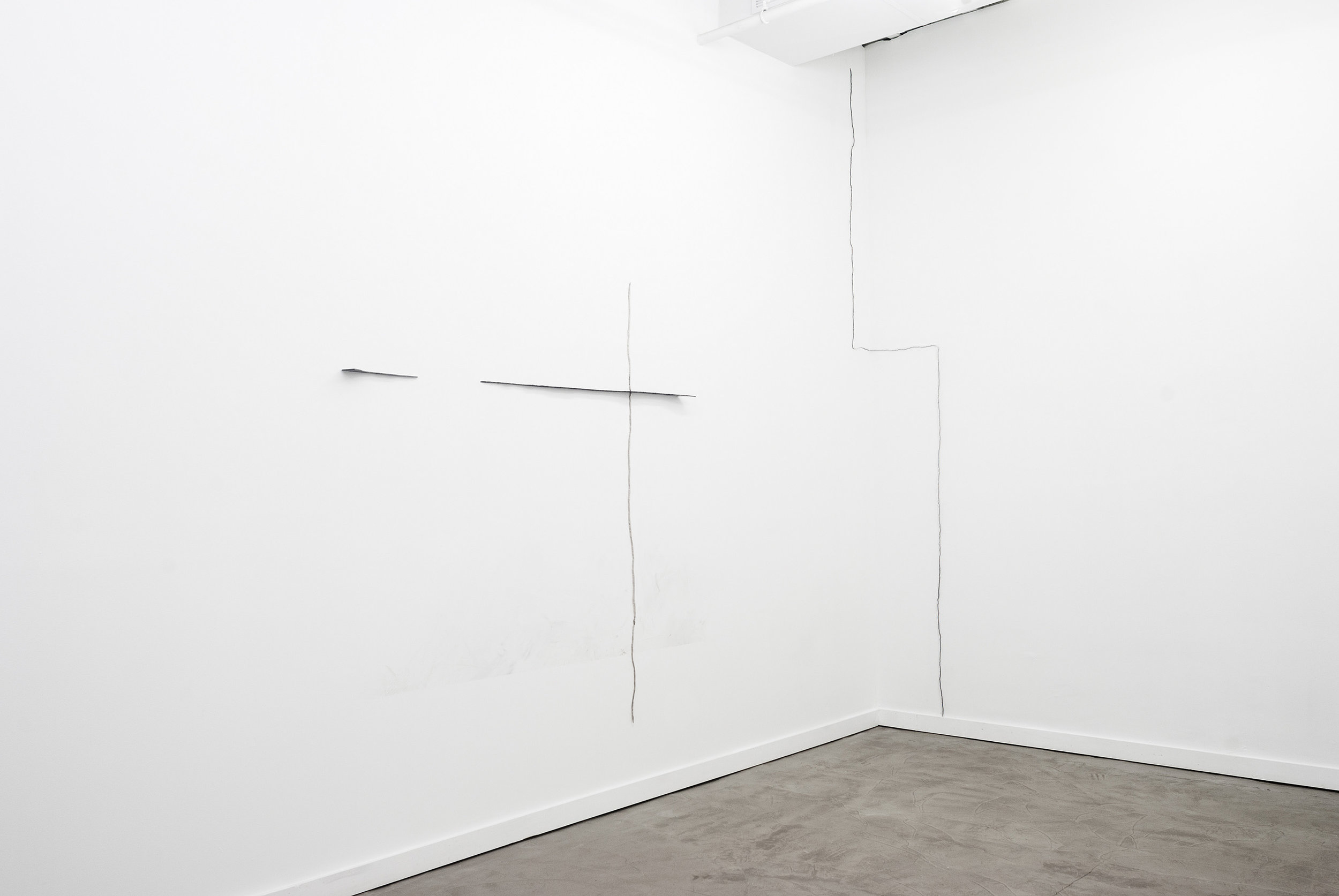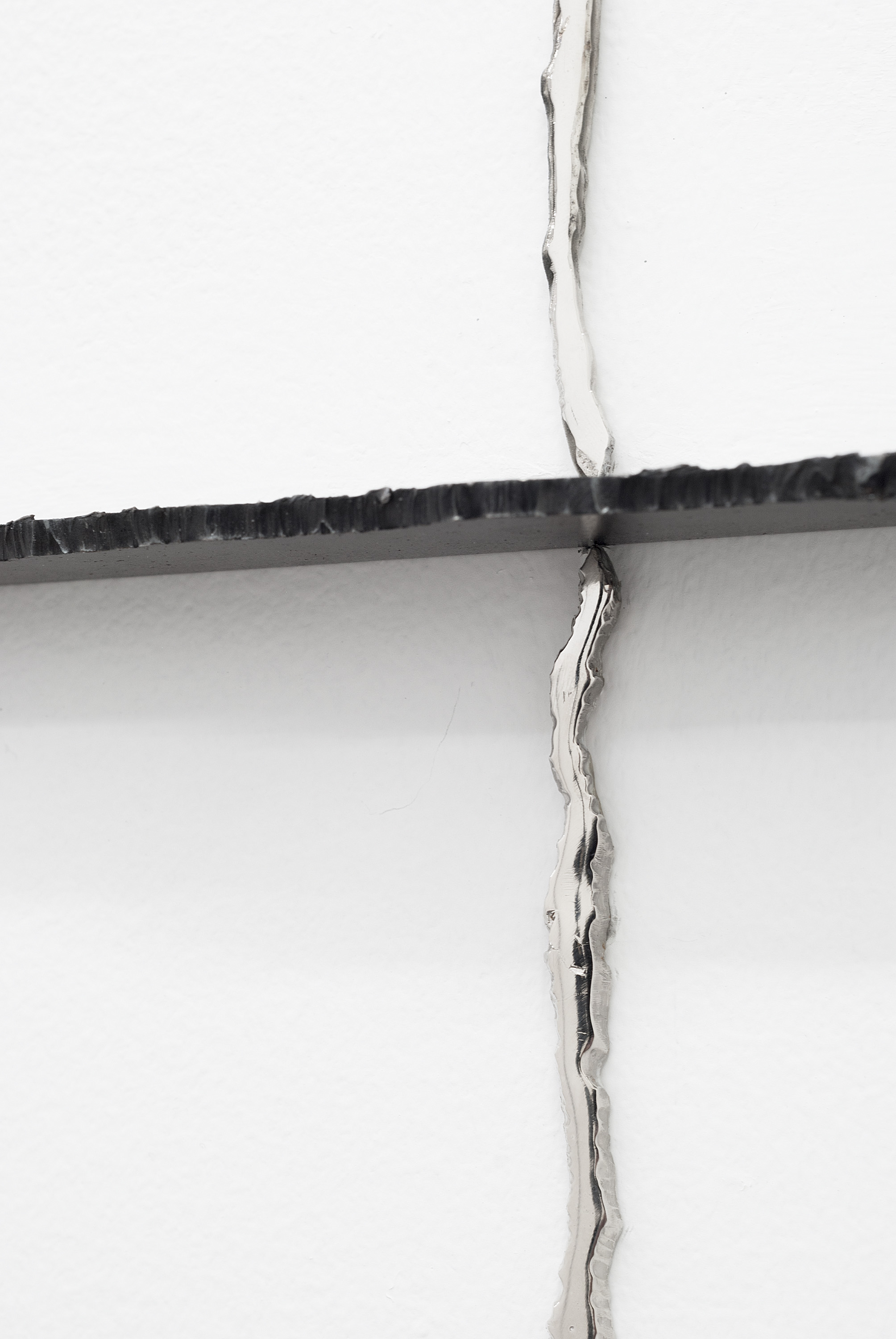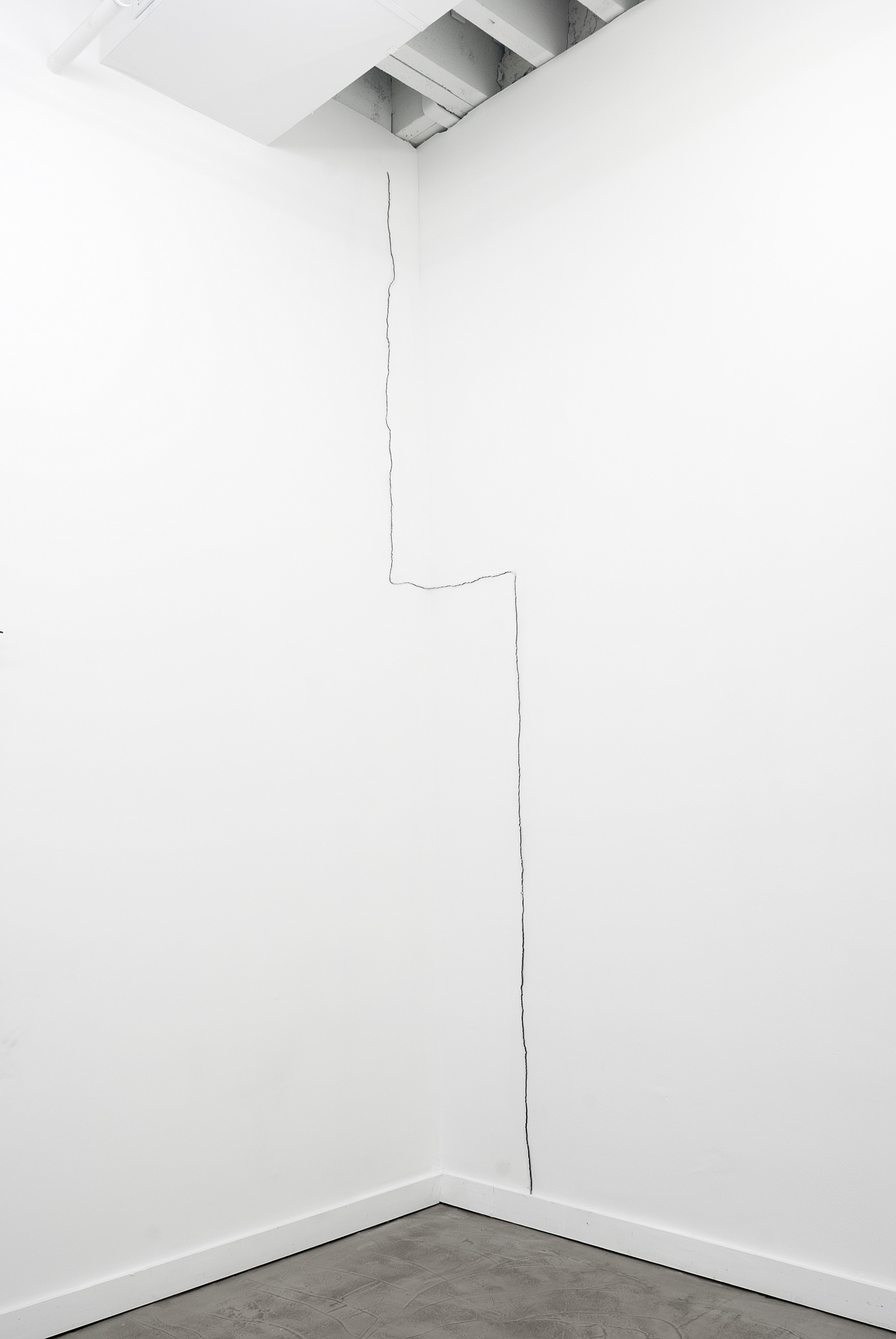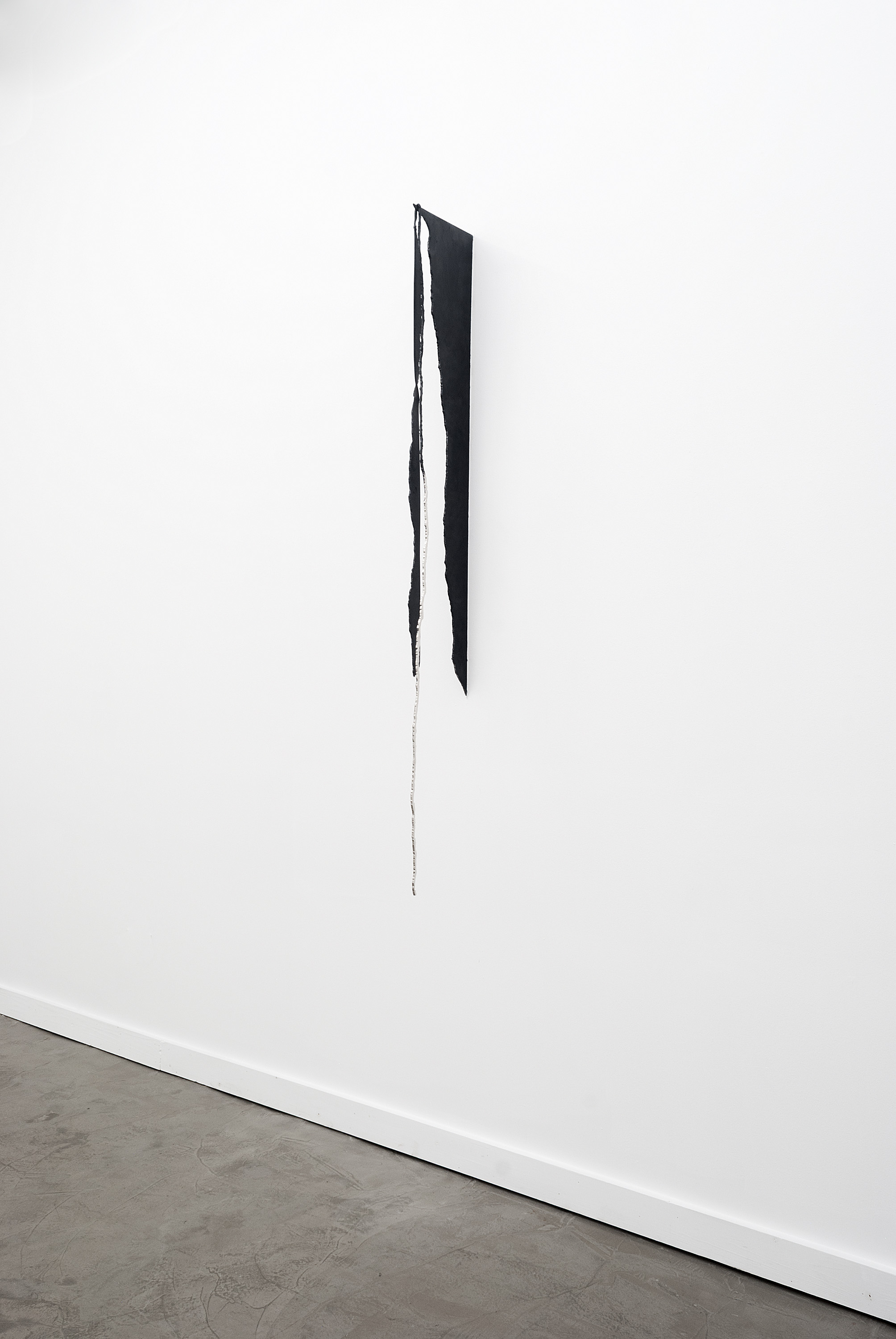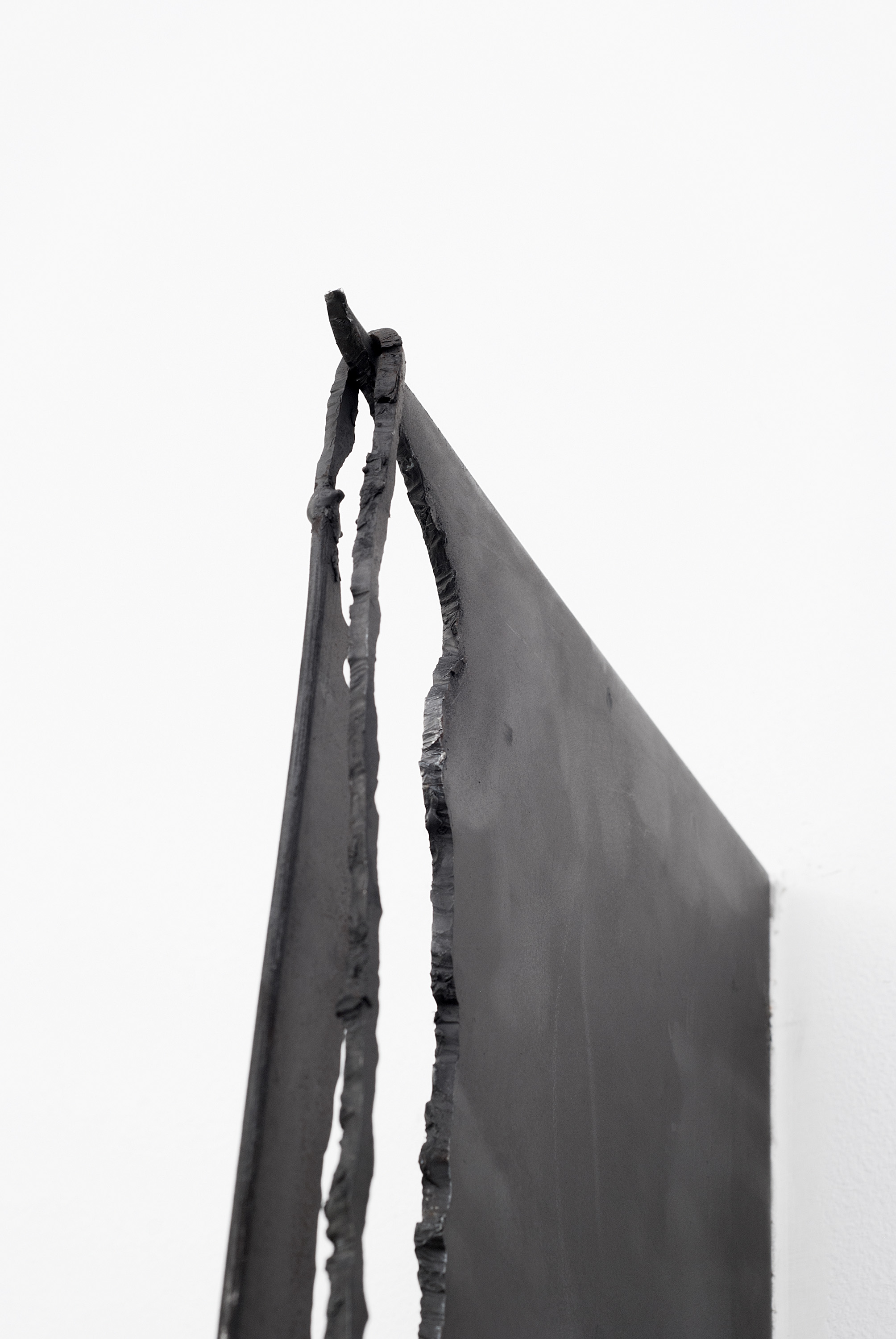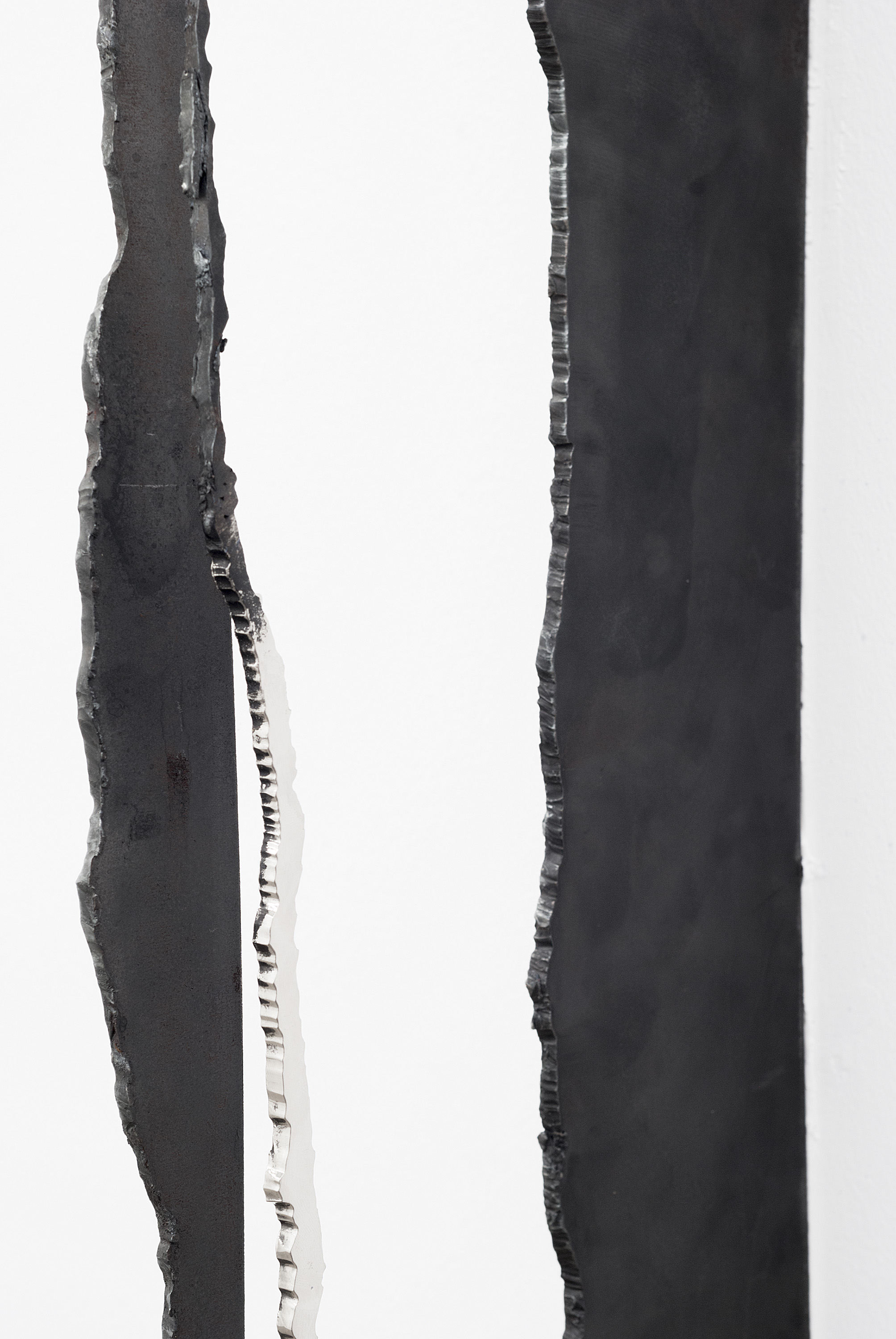Lines and Cracks
Exhibition Archive
Lines and Cracks and Zebras and Horses
Los Angeles
Installation view
Press Release
OHWOW Gallery is pleased to present Michael Genovese’s second solo exhibition with the gallery, titled Lines and Cracks and Zebras and Horses – a recently completed body of work based on lineation, cleave, and the concept implied by the aphorism: “When you hear hoof beats behind you, don’t expect to see a zebra.” A series of plasma-cut steel wall reliefs located throughout the gallery compose a subtle arrangement based equally on materiality and concept.
These raised, sculptural “drawings” suggest following the maxim that common sense is the shortest distance between two points or to recognize the grace in directness. Genovese recreates various, common occurrences of line – an architectural fracture; a hair in the bathtub; the mark of automatic writing; a military line of demarcation; a varicose vein, or a simple fabric seam. He considers where these delineations appear, why they develop, and how they are finally perceived. With a piece titled Mimesis, 2012, Genovese merges a crack found in a Pompeii fresco with a line from Metallica’s …And Justice for All album cover artwork. By stitching these unrelated strands together, Genovese formulates a new pattern, but one that still reads as spontaneous as chance. The compound of seemingly disparate fissures subsequently reveals self-similar patterns, as in the logic of fractal mathematics. Therefore, variations in contour between unrelated sources are not as far removed from one other as they may first appear, and conceptually framed, what one assumes a chasm may actually serve as a suture.
Michael Genovese creates work that aims to connect with collective experiences, be it social or existential. He speaks to the familiar; however, through mark making, reduction, or transformation of the recognizable, he reassigns power. Rather than eliminating evidence or obscuring facts, he re-contextualizes our perception of meaning and history. His work deals with archives, permanence, and the designation of value. His concern with materiality and the treatment of his chosen media furthers his investigation of worth. Genovese’s particular approach, and the work’s content, move to alter our preconceptions, changing our proximity to what is tangible. Lines and Cracks and Zebras and Horses traces pressure, time, and the role of division, or more aptly put, it traces the ideology of those measures, questioning why we don’t see something for what it isn’t.
Installation video of Michael Genovese, Lines and cracks and zebras and horses at OHWOW Gallery
...But not simpler...
Catalog Essay by Shamim M. Momin
Installation view
Orion, Nickel plated and mirror polished plasma cut steel, 1/4 X 120 inches, 2013
The title of Michael Genovese’s exhibition (Lines and Cracks and Zebras and Horses) draws in part on a colloquial aphorism — “when you hear hooves beat behind you, don’t expect to see a zebra” or “when you hear hooves beat, think horses, not zebras” — which typically is understood to evolve from the principle of Occam’s (or Ockham’s) razor. Attributed to the 14th century logician and Franciscan friar William of Ockham, the principle states, “Pluralitas non est ponenda sine necessitate,” or “Entities should not be multiplied unnecessarily.”
Over time, this principle has been largely misunderstood to mean that as a general rule, in both science and philosophy, one should stick with the most “obvious” hypothesis or conclusion, as that is typically the correct one. In fact, what Occam proposed was a guideline to developing a theory, not a conclusion: the idea that when you have competing theories that make the same predictions/conclusion, the simpler is better. Importantly, the notion of simpler is not necessarily what seems most obvious (which usually includes one’s untested biases, preferences and predilections), but rather the one with the most observable elements (empirically testable), the fewest new assumptions. It is a means to keep one’s focus rigorous, to start with the things we can observe, and not yet add to it the seduction of complex settings to achieve the same goal. It is, merely, a way to begin, a rule of thumb—not a scientific axiom as it is often employed. Also critically, while intended to separate two theories that make the same predictions, it in no way precludes that another theory might make a different prediction altogether about the same phenomena. It does not deny the complexity of organisms, it just suggests a complex thing does not obviate the expectation of empirical simplicity. It does not promise that our notion of ‘simple’ (a subjective term if there ever was one) might not be quite different from that of, say, quantum particles, why the sky is blue, the light of stars, or the reason/function of a cat’s purr.
The zebra/horse aphorism is interestingly vague in its setup, particularly in the first phrasing cited above. That is, one might could read it as a metaphorical interpretation of the Occam’s razor, wherein the horse is the more observable, simpler theory and the zebra the more unprovable, speculative, with the hooves beats are the conclusive result (the same in both “theories”) — in which case it’s reasonably true to the original principle.
It could also be understood in as the more common misreading of Occam, suggesting that more often than not, the most common conclusion is going to be correct more times than incorrect. The phenomenon is hooves beat overheard, the conclusion should be horses that cause it — it’s a law of averages idea. However, one should note that assumes the listener lives where horse geographically outnumber zebras, a fact true for a large portion of the world’s population, but not all. While it’s still overall the greatest probability, it is still based on assumptive conditions; there is a simple contextual set where this would not be a good idea (i.e. certain plains and mountains of Africa). In this way, it’s actually used most often in medical disciplines, for diagnosis — and in turn coined the term “zebra,” for those uncommon diagnosis that require exactly the kind of contextual thinking, attention to possible unique, unusual circumstances, that the probability approach smoothes out (fans of the excellent, if hyperbolic, show, House, are familiar with this scenario…). What I like about this misinterpretation is that it embraces the idea of embracing what’s not there, meaning those moments are real, if less familiar, and they do exist, quite often in exactly the spaces where we assume the familiar should be. It says “think horses,” or “don’t expect a zebra,” — not that they don’t exist, that they might not be what you see when you do turn around and look.
I saw this on a sign recently, “science is the poetry of reality,” a thought with which I wholeheartedly agree. Genovese’s exhibition similarly takes this poetry of reality — the quiet, overlooked bits and pieces of things we see and alchemizes them (to silver, in this case, not gold, but the metaphorical notion retains). Drawn from disparate, often familiar or banal moments of lines and cracks, the delicate, quiet sculptural interventions reconsider and combine occurrences as varied as a crack in the artist’s kitchen floor, a damaged mihrab from 12th century Iran, a varicose vein (a sub-epidural “crack,” if you will), a line from a captcha (those computer tests that determine a human is using the site, not a machine), and the seam line of an Ancient Greek horse head sculpture, and the stress fracture from a brick building in Compton.
Cracks are typically perceived as the break between two parts, or rather the imminent breaking into parts of what was once whole. Lines, on the other hand, stand stalwart in better graces, that which connects two points, and is often the shorter way between disparate things. While it’s been knocked about quite a bit philosophically and ideologically, linear thinking is a point of pride for many, in that it implies a clear succession of points of cause and effect culminating in a empirically supported and useful conclusion. “Cracked” as an adjective, however, is a synonym for crazy, or at least not quite right, crooked, off-kilter. Lines, good, cracks, bad.
Lines and Cracks and Zebras and Horses”: in that grammatical setup, it seems to parallel lines with zebras, cracks with horses. Following the logic above, this would suggest that ‘lines’ are the less empirically likely to be the right theory, while ‘cracks’ the better assumption in similar situations, cracks. This seems a reversible of expectation, combining the common connotations of all these, one would expect to find the zebras in the cracks, and let the horses follow the lines. However, the parallel is not strictly correct; rather than a comma between the couplets, Genovese connects them with the same conjunction, “and,” making them technically a list of equivalent things. Perhaps lines aren’t the best or shortest ways between objects or places, perhaps they separate rather than connect parts. Perhaps cracks show richness formerly hidden, reveal depth where there was only surface, or function as a suture point that holds things together with true delicacy and vulnerability. Perhaps probabilities change, other options are equally likely, or the unlikely just isn’t unlikely that time—it will be easier to see zebras today, or another uncommon ungulate: a camel, a deer, an elk, a donkey, a gazelle. Perhaps, even once, those hoof beats are a unicorn instead.
Shamim M. Momin is an American art director and curator of contemporary art. Momin is head of the Los Angeles Nomadic Division, a non-profit art organization in Los Angeles, California. She is also an Adjunct Curator for the Whitney Museum of American Art where she co-curated the 2008 and 2004 Whitney Biennial exhibitions.
MICHAEL GENOVESE, LINES AND CRACKS AND ZEBRAS AND HORSES, 2013
Installation view
Published by OHWOW (2013) Hardcover, 96 pages, fully illustrated featuring an essay by Shamim Momin
Detail
Spotting cracks in the system
Los Angeles Times, Sharon Mizota | pg. D18-19 | January 25, 2013
Manicured fields of failure, Nickel plated and mirror polished plasma cut steel, 1/4 X 98 inches, 2013
Walking into Michael Genovese’s exhibition a viewer might think there’s been a horrible earthquake, or that the space is simply in a state of disrepair. Snaking over the surface of every wall are large, meandering cracks, with unsettling implications for the building’s structural integrity.
But this unease dissipates quickly. The fissures are in fact shiny and metallic, as if filled not with putty but quicksilver. And closer inspection reveals that they are not cracks at all but cut metal objects, affixed to the walls.
This realization feels like a bit of bait-and-switch. Genovese’s installation comes on like a site-specific piece — an engagement with the space of the gallery itself. But the fact that the “cracks” are actually individual sculptural pieces that can be removed and possibly reapplied to different walls feels cynical. They are then just objects to be bought and sold.
Not that there’s anything wrong with that. But additional context is provided by a photocopied book depicting fissures and lines of all kinds: cracks in the sidewalk, maps, zebra stripes, a pendant split into two halves.
Genovese is interested in how lines divide and connect; create distance or communication. His sculptures turn these vectors into objects in their own right, emphasizing the spaces in between rather than on either side. In our increasingly Balkanized political climate, it’s a more than welcome metaphor.
Mizota, Sharon. “Spotting Cracks in the System.” Los Angeles Times, p.D18-19, January 25, 2013
“Shards of Hope.”
The Cornell Sun, Daveen Koh, January 31, 2013
Installation view
Seem, Seam from band, Nickel plated and mirror polished plasma cut steel, 8 X 120 X .25 inches, 2013
Visitors to artist Michael Genovese’s solo show Lines and Cracks and Zebras and Horses in Los Angeles have cause for concern — massive, silvery cracks run along the otherwise pristine gallery walls. The room appears to be on the verge of crumbling. These fault lines are not really chasms (although you can never really be sure about these things in contemporary art). They are more like casts of chasms, memorials to anything that might take on the form of a line, however sacred or banal. Accompanied by a book of line-dominated images, notably a thunderous herd of zebras, the impossibly reflective sculptures are arresting for their scale and symbolism. Each sculpture is the convergence of disparate worlds: Pompeii frescoes meet Metallica; a crack from an Iranian Mihrab dated 720 A.D. fuses with a mortar line from the vicinity of Castillo de San Marcos in Florida. Looking at them, it’s entirely appropriate to feel like you’re in the throes of an earthquake.
In an interview with Genovese explained that his work is about “designating value” to fragments of life. Whether it’s staring at stray hairs in the bathtub or gazing at a historical landmark (a very loaded term, in the context of this show), these moments mean something because, in that instant, we are registering the things around us and trying to make sense of them. By turning a crack, usually associated with damage, into a sculpture, Genovese alters the meaning of the crack.
I like Genovese’s work. It can be simultaneously gentle and violent as it interrupts the everyday and forces you to look at everything twice. The art I am most drawn to often doesn’t conventionally look like art. It’s the kind of art that can be mistaken as debris and accidentally get cleared away by a zealous museum cleaner, as happened to Gustav Metzger’s installation at the Tate Britain in 2004. Incidentally, Metzger’s work was conceived as a comment on the finite nature of art.
Another urban intervention is The Shard, presently the tallest building in Western Europe and London’s highly metaphorical monument to the new kind of financial world, among other things. The Renzo Piano-designed building, with a top like a shattered beer bottle (as The Guardian’s architecture critic Oliver Wainwright has rightly pointed out), is a baffling and unmistakable sight in London’s South Bank.
Among the most prescient critics, I think, is Prof. Hal Foster, art, of Princeton University. In an interview with The Guardian, Foster prefaced his critique of the building by admitting his ambivalence about perceiving the building as image. It is too tempting for many critics to condemn The Shard as no more than spectacle. Foster does not succumb. He reminds us that architecture can bring order to urban life, and “too often in cities people are lost” as they don’t have “symbols to guide them.” The Shard, a striking pyramidal assemblage of splintered triangles, could certainly come in useful as a landmark. That’s at least one point its detractors can agree on. Foster’s allusion to orientation is also unsurprising, since it’s a well-established tenet of urban theory. The landmark is one of the five elements of the city’s new image proposed by the urban planner Kevin Lynch; the stronger and more prominent these elements are and the more harmoniously they are stitched together, the more legible a cityscape is.
I found most of Foster’s commentary almost disappointingly uncontroversial, until he seemed to light up, near the end, when he likened The Shard to “radical surgery” where “they stick a needle into your heart to get it to go again.”
The violence Foster employs is, I believe, justified. His view is that, juxtaposed with other iconic buildings like the Borough Market, The Shard disrupts the neighborhood. There is no attempt at mediation, to bridge the gap in scale between the pedestrian strolling along the Thames and the gargantuan building. I am inclined to agree with Foster’s assessment, though I will add that if The Shard is indeed a monument to a glittering financial world, then the violent disruption is fitting.
Meaning making is a highly tenuous exercise, as should by now be obvious. The more theory I try to read, the more apparent it seems that interpretation is the unification of seemingly unrelated elements, like how Genovese merges ancient Italian frescoes with American heavy metal. Nevertheless, the whole exercise makes perfect sense to me, because I have never been able to forget the words of the first theorist I encountered at Cornell. In The Image of the City, Kevin Lynch wrote, “Nothing is experienced by itself, but always in relation to its surroundings, the sequences of events leading up to it, the memory of past experiences.” I know it can all go very wrong — you can end up very lost or injured as you invest more of yourself into everything that you read and write. There’s also a fine line between creative interpretation and well, delusion, and who should be the judge of where that boundary lies? When so many others seem to have said something cleverer, why should I expect to arrive at something newer and better? I defer to the wisdom of those who have sought and found. Former Prof. Colin Rowe, architecture, wrote in The Cornell Journal of Architecture with characteristic adventurousness, “Therefore to agitate and to animate a very few ideas we will begin with a set piece which is going to be partly history and partly parable.” Or more simply put by Renzo Piano, designer of The Shard, “The best things in life are always a little dangerous.”
Joliet
Solo Exhibition at Paris London Hong Kong, Chicago
Essay by Shannon R. Stratton
Installation view
Installation view
In university my friend, a former ballerina, discovered she had caused a stress fracture in her shin from working out too much at the gym. Sometimes described as a hairline fracture, I imagined watching this crack creeping across my friend’s leg like a
sheet of ice crazing under my foot as my full weight came to rest on its cool surface. Or, to put the emphasis on the “stress,” I imagined my entire body slowly shattering when the weight of anxiety or fear or loneliness could be felt too heavily on my mind, my shoulders, my heart.
While I’ve seen cracks and crazes, and fractures and fissures, the imagining of the incident, the slow traveling of the fractures path as it tears, at a meandering pace, throughout he matter that it is dividing, has resonance. It’s a sharp pang in the stomach you let slip between your fingers the moment , the person, the place, and it falls away from your grasp for good. It’s an ache as a distance stretched out between you and a loved one when the last words exchanged drive you further apart and you both watch, dumbfounded, as this last breach gapes wider, it’s a twinge in your heart as you taste the bittersweet. It’s the distress that crumples the mind, fragmenting into a million little cavities that hold a million little details that can no longer be held together. It’s the sting of disappointment that splinters the ego, as bad news comes to rest. And it is also the stitch, that creeps down your side, marking a moment of exertion when your body feels the last burst of its efforts in a sensation that both severs and joins it, a sensation of both pain and triumph.
Is this what it means to suffer fracture? Is it only pain? An emotional rending that leers its way through nerves and blood and bone and flesh and heart and brain like a surge of electricity cuts through the sky? And why then, is it only sometimes beautiful? Lightening surely fills us with awe, but the soft crazes of a porcelain tea cup or the fissure that worms its way through marble, have a sense of history that soothes us, while the crack that bursts through plexiglass is an eye sore. The plexiglass is ruined, it’s purpose marred and impaired by the crack, but the marble has acquired more character. The fissure is at home with the gently worn depressions where a million feet have been given support as the beat a path to and fro.
I work my way through this emotional inventory of pangs and twinge, stitches and stings, and wonder which mar the person and which lends him character? What aches make us beautiful, while others weaken our core?
Michael Genovese titles his exhibition “Joilet” The not so little town that butts up against Chicago, who’s weight perhaps tore it from Cook County early on, to become the seat of Will County to the SouthWest. Its great prison looming large throughout it’s life, until it closed in the early 2000's as its buildings aged into hazardousness. Joliet’s prison weaves itself into art into American Poetry and Music and film, a great looming icon of the great fractures that weaken us all, in the most complicated off ways, systematically, socially, politically.
And then there is the Des Plaines river, that cuts Joliet in two. The River that brought its namesake, French Canadian explorer Louis Joliet, to camp on a mound no in the South West of the city in 1673. A mound that was later mined until it became a depression. It’s excavation, through perhaps a thousand stabs of a pick ax or blasts of dynamite, leaving a hollowed out summit, deflated onto itself.
Or perhaps Joliet conjures something else, as the nucleus of fracture; a city that has lived its life as a transportation hub with riverways and railways and highways meeting meeting and radiating from here. An allusion to the heart from which a fracture emerges. The site of impact as well as the site of termination, as just as many ways come to an end here, as they are gotten underway.
Is the nucleus of the pang, the twinge, the ache, the heart? Does Joliet shimmer and become once again Juliet? Now, Shakespeare’s heroine for whom the intensity of young love shatters her very core, yet in the end reconciles two families fractured from years of feuding. A dagger plunged into a heart; is at once a violent stitch that repairs a rift.
For an artist who has spent much time with writing and the meaning wrought by inscription, whether invited or in the case of graffiti, renounced, Genovese’s cracks are also another script. But unlike a script that fills in the gaps, it instead marks an event or the event makes the mark and the particulars of the story are vacated. The marks that are left, the cracks the fissures are a record whose language we are fluent with only effectively, allowing legibility only through filling the lacuna on either side of these fractures on their left or right, before or after) with our own collisions.
Genovese’s cracks are nickel plated steel. They crawl the wall like rivulets of ore to be mined, river ways carving up the drywall and heartache, cast and preserved bijoux that gives the room character. They are copies, these cracks, that remember a history that marks another matter, but here cut from their origins, they are meditations. Pauses that are divorced from spectacle and dazzle, yet manage to pay respect or honor in their heft and their might and subtle shine) the great events, the affairs, the phenomena whose full weight is brought to bear and registered, as fracture. A life lived is inscribed by the cracks and the fissures; the big events are permanently worn and remembered. - Shannon R. Stratton
Joliet
Exhibition review by Monica Westin for Newcity, September 17, 2013
Detail
Michael Genovese’s linear wall reliefs mimic the everyday cracks in pavement, walls and other human structures that surround us; they also serve as traces and indexes of the less tangible fractures around us. His current exhibition at Paris, London, Hong Kong (the new gallery’s second show), “Joliet,” references the city that brands itself the “crossroads of Mid-America” and has historically served as both a railway transportation hub and a site for adult and juvenile prisons. Genovese, originally from Chicago, uses these local associations to his advantage, giving the slick, nickel-plated, mirror-polished steel cracks that crawl across the gallery space more political and historical weight. But the formalisms of the cracks themselves stand alone as repositories for abstract imagery from natural and invented worlds: like stitched seams, imagined lines of constellations, and uncanny growth of strange plant life, they seem filled with forces of gravity and grace, dripping down walls or attempting to scale and branch. The overall effect recalls Charles Ray’s famous declaration about “Hinoki,” on view at the Art Institute of Chicago, that he was trying to “breathe intentionality into” the found rotting log that he copied in a wooden sculpture. Nickel-plated pipes and occasional sculpture offer counterpoints, as do some apples of different colors cut in half and rubber-banded together — a suggestion that we ought to take the show somewhat playfully — and the artist book “Lines and Cracks and Zebras and Horses,” which combines Genovese’s photographs of found cracks with shapes that echo them.
Author Bio
Monica Westin is an arts writer and historian of rhetoric based in Oakland. A regular contributor to Artforum.com (reviews) and BOMB (interviews), Monica’s criticism, essays, and interviews related to art and aesthetics have also recently appeared in PBS’s Art21, Art Forum, ,The Believer, The Brooklyn Rail, Raw Vision, VICE technology blog Motherboard, and 3 Quarks Daily. Since moving to the Bay Area in 2013, her writing has appeared locally in SFAQ and Daily Serving.
Mimesis
P.P.S. at the Frost Art Museum
Mimesis, Nickel plated mirror polished steel wall relief and source material. Frost Art Museum, 2012














